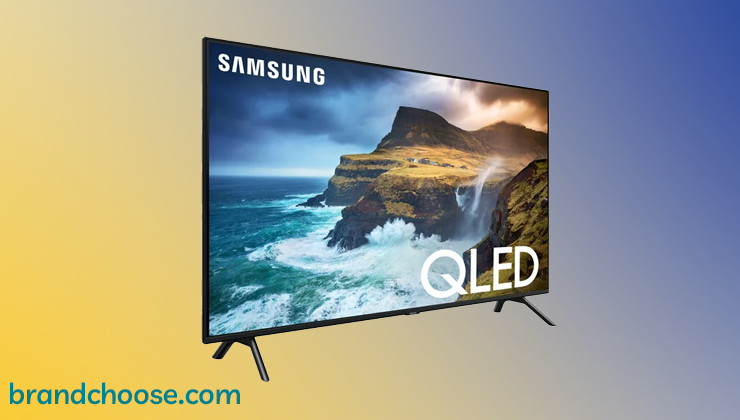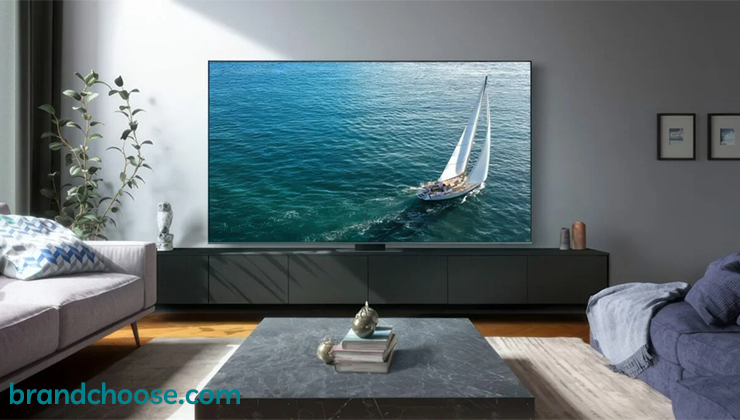Highlights
Low input lag and advanced gaming features
Full HD, 4K UHD, and even 8K resolutions
Expensive compared to similar brands
Vibrant colors, high brightness levels
New models quickly make outdated
Seamless access to apps
In today's digital age, the television has transformed from a simple viewing device to a sophisticated entertainment hub, offering immersive experiences and cutting-edge features. Among the multitude of brands in the market, Samsung stands out as a pioneer in television technology, continually pushing the boundaries of innovation. From stunning visuals to intuitive interfaces, Samsung televisions redefine the way we engage with content, making them a cornerstone of modern living rooms worldwide. In this article, we delve into the world of Samsung televisions, exploring their standout features, technological advancements, and the unparalleled viewing experiences they offer.

Affordability
3.3 /5
Samsung offers a broad range of televisions that cater to different budgets, but it is primarily known for its premium models, including QLED and Neo QLED televisions, which often come with a higher price tag. While these high-end options justify their cost with cutting-edge technology, stunning picture quality, and a rich feature set, Samsung also provides a variety of mid-range and budget-friendly models. These more affordable options allow consumers to enjoy impressive performance without straining their wallets, making Samsung a versatile choice for a wide audience.
When compared to competitors like Sony, which tends to focus more on premium pricing for its OLED models, Samsung provides a balanced offering that appeals to both budget-conscious consumers and those seeking top-tier features. Brands like LG also compete in the affordability space with competitively priced OLED models, but Samsung’s extensive range ensures that there’s something for everyone, whether you're looking for a simple smart TV or a high-end cinematic experience.
Picture Quality
4.6 /5
Samsung is renowned for its exceptional picture quality in the television industry, leveraging the latest technologies such as Quantum Dot technology, High Dynamic Range (HDR), and 4K Ultra High Definition (UHD). Quantum Dot technology, used in their QLED TVs, allows Samsung televisions to produce over a billion shades of color, resulting in vibrant, lifelike images. HDR, on the other hand, enhances the contrast and color range, allowing for deeper blacks and brighter whites. The 4K UHD resolution offers four times more pixels than Full HD, ensuring sharp and detailed images. However, while Samsung TVs generally offer excellent picture quality, they may not always match up to the OLED technology used by brands like LG and Sony, which can deliver perfect blacks and infinite contrast ratios. Additionally, some users have reported issues with viewing angles on certain Samsung models, meaning the picture quality can degrade when viewed from the side. Despite these minor drawbacks, Samsung's commitment to innovation and their use of cutting-edge technology often makes them a strong contender in terms of picture quality compared to other brands.
Design
4.6 /5
Samsung, a leading brand in the television industry, has consistently been recognized for its innovative and aesthetically pleasing design. Samsung televisions, particularly the high-end QLED and The Frame series, feature a sleek, minimalist design that seamlessly blends into any living space. The brand's design philosophy is centered on creating a harmonious balance between the television and its surroundings. For instance, The Frame series is designed to mimic a picture frame, allowing users to display art when the TV is not in use, enhancing the aesthetic value of the room. One of the latest design technologies introduced by Samsung is the Ambient Mode, which allows the television to blend into the wall behind it by displaying images that mimic the wall's pattern. This feature, available in the QLED series, takes the minimalist design concept to a new level. However, while the design of Samsung televisions is undoubtedly impressive, it may not appeal to everyone. Some users may find the minimalist design too stark or the Ambient Mode unnecessary. Additionally, compared to other brands like LG or Sony, Samsung's design-focused televisions tend to be more expensive. However, when it comes to design innovation, Samsung is a clear leader, consistently pushing the boundaries of what a television can look like.

Sound
4.5 /5
When considering the aspect of sound in the category of electronics, Samsung as a brand has made significant strides in enhancing the audio experience for its users, particularly in their television models. Samsung televisions are equipped with the latest sound technologies such as Dolby Atmos, Q-Symphony, and Object Tracking Sound (OTS) that provide immersive and three-dimensional audio experience. The Dolby Atmos technology, for instance, creates a 'surround sound' effect, making the viewer feel as though they are in the midst of the action. However, some users have reported that the bass could be more powerful, and in some models, the sound may not be as crisp at higher volumes. On the other hand, televisions from other brands also offer a range of sound technologies. LG, for example, uses Dolby Atmos technology in their OLED TVs, and Sony uses Acoustic Surface Audio technology which vibrates the TV panel to produce sound directly from the screen. While these technologies also provide an immersive audio experience, some users have reported inconsistencies in sound quality across different models. In comparison, Samsung's sound technology tends to be more consistent across its different television models. However, the ultimate choice between Samsung and other television brands would depend on the specific sound preferences and needs of the user.
Quality & Performance
4.6 /5
Samsung is globally recognized for its exceptional quality and performance in the television industry, using the latest technologies to enhance user experience. Samsung's QLED and Neo QLED TVs, for instance, are equipped with Quantum Dot technology, which provides superior color accuracy and brightness. In terms of performance, Samsung TVs stand out with their powerful Quantum processors which upscale content to 4K or 8K resolution, ensuring a high-quality viewing experience. However, while Samsung televisions offer high-quality visuals, they tend to be on the pricier side compared to other brands offering similar features. Additionally, some users have noted that the viewing angles on certain Samsung models may not be as wide as those offered by competitors, such as LG's OLED TVs. Despite these minor drawbacks, Samsung's quality and performance in the television category remain competitive, consistently ranking among the top brands in the market. The brand's commitment to innovation and quality assurance is evident in its advanced features like AI upscaling, adaptive sound, and anti-reflection screens, which all contribute to an enhanced viewing experience.
Brand Reputation
4.8 /5
Samsung has a well-established and highly respected reputation in the television industry. The brand is known for consistently delivering high-quality products that incorporate the latest technologies, including QLED, 4K resolution, and smart TV capabilities. Samsung's televisions are often praised for their exceptional picture quality, innovative features, and sleek, modern design. They are also recognized for their longevity and reliability, which contributes to the brand's strong reputation. However, Samsung televisions tend to be on the higher end of the price spectrum, which may be a deterrent for some consumers. While the brand's reputation for quality and innovation is well-deserved, there are other brands, such as LG and Sony, that offer comparable products at a lower price point. Despite this, Samsung's brand reputation remains strong due to their commitment to innovation and quality. They continue to be a leading player in the television industry, consistently ranking high in consumer satisfaction surveys and expert reviews.
Brightness
4.6 /5
Samsung televisions are renowned for their impressive brightness levels, which significantly enhance the viewing experience. The brand's latest models, such as the Samsung QLED TVs, use Quantum Dot technology. This technology allows the televisions to reach a peak brightness level of 1500 to 2000 nits, making them some of the brightest TVs currently available on the market. The high brightness levels are particularly beneficial for viewing HDR content, as they allow for a more detailed and vibrant image representation. However, it's important to note that while the high brightness levels can enhance the viewing experience, they can also lead to more power consumption. Additionally, in extremely bright scenes, some viewers may notice a slight blooming effect, where bright objects can cause a halo of light to spill over into darker areas. Compared to other brands, such as LG and Sony, Samsung TVs generally offer higher brightness levels, making them a preferred choice for viewers who prioritize brightness and picture clarity. But, these other brands may offer better performance in other aspects, such as black levels and color accuracy.
Smart Features
4.7 /5
Samsung's Smart TVs are renowned for their advanced smart features, which are powered by the brand's proprietary Tizen operating system. This system provides a user-friendly interface that is easy to navigate, and it supports a wide range of apps, including popular streaming services like Netflix, Amazon Prime, Disney+, and Hulu. Samsung Smart TVs also come with the SmartThings app, which allows users to connect and control their smart home devices directly from their television. One of the latest technologies Samsung has introduced in their Smart TVs is the Bixby voice assistant. This feature enables users to control their TV and search for content using voice commands, providing a hands-free viewing experience. However, some users have reported that Bixby is not as responsive or accurate as other voice assistants like Google Assistant or Alexa. In terms of comparison with other brands, Samsung's Smart TVs are often praised for their extensive app support and seamless integration with other Samsung devices, but they are also typically more expensive than their competitors. Despite this, the brand's commitment to innovation and quality makes their Smart TVs a worthy investment for those seeking advanced smart features.
Remote Control
4.5 /5
Samsung's television remotes are designed with the latest technologies to provide a seamless user experience. One of the key features of Samsung's remotes is the One Remote Control, which allows users to control all compatible devices and content with a single remote. The remote also supports voice control, thanks to the integration of Bixby, Samsung's voice-activated assistant. This feature enables users to change channels, adjust the volume, and even ask for recommendations by simply speaking into the remote. However, there are a few downsides to Samsung's remote controls. Some users have reported that the voice control feature is not always accurate and can sometimes misinterpret commands. Additionally, the minimalist design of the remote, while sleek and modern, means that it lacks some traditional buttons like a number pad, which some users might miss. Compared to other brands like LG and Sony, Samsung's remote control offers a more streamlined design and advanced voice control features. However, LG's Magic Remote, for example, offers motion-control capabilities, which Samsung's remote lacks.
Related Video
Conclusion
In conclusion, Samsung televisions represent the pinnacle of innovation and excellence in the realm of home entertainment. With their state-of-the-art display technologies, smart features, and sleek designs, Samsung televisions redefine the viewing experience, transporting audiences into a world of immersive entertainment like never before. As technology continues to evolve, Samsung remains committed to pushing boundaries and delivering groundbreaking solutions that enrich our lives and redefine the way we experience television. So, whether you're a cinephile, a gaming enthusiast, or simply seeking unparalleled visual experiences, Samsung televisions stand ready to elevate your viewing experience to new heights.





